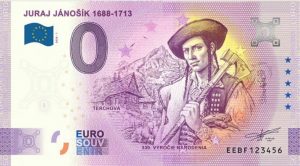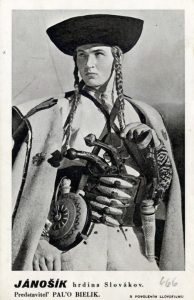
The real-life story of Juraj Jánošík
Juraj (also known as Juro or Jurko) Jánošík was a fabled Slovak highwayman who achieved great notoriety in Eastern Europe during the early part of the 18th century. Despite his humble beginnings, short life and outlaw lifestyle, he has nevertheless gone on to become one of the best-loved heroes of Slovak folklore. Traditionally depicted clad in peasants clothing, often carrying a shepherd’s axe, he is said to have robbed only from the rich to give to the poor. Inevitably, dozens of retellings, legends and myths, surrounding the life of Juraj Jánošík have developed since his death, over three hundred years ago.

The fabled Juraj Jánošík is famously depicted on a Slovakian banknote.
Early Life
It is thought Juraj Jánošík was born a few days before his known baptism date of 25 January 1688. The son of Martin Jánošík and Anna Čišníková, he grew up in the village of Terchová, which is now in the Žilina District of Slovakia. However, in the late 17th century the area was part of the Hungarian Hapsburg Empire, essentially under the control of Germany. At just fifteen, Jánošík was already fighting with the locally impoverished Kuruc insurgents against the control of the Hapsburg Dynasty. However, in 1708, after the Kuruc had lost the decisive Battle of Trenčín, Jánošík was recruited by the Habsburg army.
By the Autumn of 1710, Jánošík found himself working as a prison guard in Bytča, present-day northwest Slovakia. It was there that he befriended an incarcerated robber, Tomáš Uhorčík, by all accounts, a somewhat charismatic character. Many believe that Jánošík was instrumental in facilitating the escape of Uhorčík from the prison. Afterwards, the pair quickly went on to form a highwayman gang. However, within a year Uhorčík had left the group to get married and settle for a more sedate life. Thus, aged 23, Jánošík, found himself the leader of a gang of up to twenty highway robbers and desperados
Gamekeeper Turned Poacher
The group were most active in the northwest part of Hungary (now Slovakia), between Važec and Východná, but also in parts of Poland and Moravia, now in the east Czech Republic. Under Jánošík’s leadership, the gang is said to have operated with a certain degree of chivalry and decorum. They targetted only the rich and used minimal force, such that none of their victims was ever seriously assaulted or killed during raids. According to experts, Jánošík’s goal as a highwayman was never just to enrich himself. His motives were equally politically and socially driven, very much in the style of Britain’s own legendary folk hero of similar stance; Robin Hood. Thus, Jánošík and his cohorts are said to have shared their plunder with the poor, making them popular figures.
However, Juraj Jánošík’s criminal career was to be a short-lived affair. In Autumn 1712, he was apprehended and detained at Hrachov in the Trenčín Region of western Slovakia. However, on this occasion, he managed to avoid prosecution and was released soon afterwards. In the Spring of 1713, Jánošík was in the village of Klenovec in the Banská Bystrica Region of southern Slovakia. According to legend, he was staying with old friend Tomáš Uhorčík, who was running an inn and living under the alias of Martin Mravec at that time.
The much-accepted story goes that whilst trying to flee the authorities, Jánošík slipped on peas that had deliberately been thrown in his way by a treacherous old lady.
Juraj Jánošík Returns To Prison
Jánošík was sent to prison in present-day Liptovský Mikuláš and for the following two months faced interrogation and torture. However, although confessing to his own crimes he never disclosed the names of any of his associates or accomplices. Neither, the true identity of Martin Mravec, though Uhorčík himself later confessed and also ended up being executed. Jánošík was put on trial in the middle of March 1713. He was sentenced to death but the exact date of his execution was never recorded. Though, it was a common practice of that time to carry out the deadly deed as soon as the trial was over. The details of his execution were not made public until the early 19th century.
Reserved for hardened criminal gang leaders, it is said a large hook was pierced through his left side from which he was strung up to the gallows and left to die. Some experts take a different view and say that is just as likely that Jánošík was hung by the neck. However, his legend begs to differ as it purports that he was offered clemency right up to the time of his execution in exchange for his expertise in the enlistment of top-class soldiers. Juraj Jánošík’s alleged response was “If you have baked me so you should also eat me!”, whereby he then proceeded to jump onto the hook himself. His execution took place at Šibeničky, where he is supposedly buried in an unmarked grave at a small cemetery, just outside of the town.
The Legend of Juraj Jánošík

In 1921, Jánošík was the very first Slovak feature film ever produced. It was financed by the Slovak-American Tatra Film Company and starred Theodor Pištěk in the lead role. A further five films featuring Jánošík were made between 1935 and 1976. A Polish 13-episode TV series on the local hero was produced in 1974, and a Slovak 28-episode animated TV series, in 1991. In 2009, a Slovak-Polish-Czech co-produced film; Jánošík: The True Story, was released. It was directed by Agnieszka Holland and Katarzyna Adamik, with Václav Jiráček in the lead role.
During the 19th and 20th century, at least 30 books, poems or plays were published or performed, where Juraj Jánošík was the main subject or featured heavily in the works. Juraj Jánošík’s image has also appeared on a number of Slovak and Czechoslovakian banknotes and coins.
In 2013, on the 300th anniversary of Jánošík’s death, his home village of Terchová erected a monument to him. The imposing statue overlooks the village from a nearby hill.

Jozef Kotulič, CC BY-SA 3.0 , via Wikimedia Commons
So there you have it our Five Minute Overview of yet another of the worlds famous highwaymen. If you’ve enjoyed reading this article check out our other notorious highwaymen articles & don’t forget to join our growing community.






… [Trackback]
[…] Find More on on that Topic: fiveminutesspare.com/education/highwaymen-juraj-janosik/ […]
… [Trackback]
[…] Here you can find 24711 additional Information to that Topic: fiveminutesspare.com/education/highwaymen-juraj-janosik/ […]
… [Trackback]
[…] Find More here to that Topic: fiveminutesspare.com/education/highwaymen-juraj-janosik/ […]
… [Trackback]
[…] Find More here to that Topic: fiveminutesspare.com/education/highwaymen-juraj-janosik/ […]
… [Trackback]
[…] Find More here to that Topic: fiveminutesspare.com/education/highwaymen-juraj-janosik/ […]
… [Trackback]
[…] Read More here to that Topic: fiveminutesspare.com/education/highwaymen-juraj-janosik/ […]
… [Trackback]
[…] Find More on that Topic: fiveminutesspare.com/education/highwaymen-juraj-janosik/ […]
… [Trackback]
[…] Find More on to that Topic: fiveminutesspare.com/education/highwaymen-juraj-janosik/ […]
… [Trackback]
[…] Find More Information here on that Topic: fiveminutesspare.com/education/highwaymen-juraj-janosik/ […]
… [Trackback]
[…] Here you will find 53644 more Information on that Topic: fiveminutesspare.com/education/highwaymen-juraj-janosik/ […]
… [Trackback]
[…] Information on that Topic: fiveminutesspare.com/education/highwaymen-juraj-janosik/ […]
… [Trackback]
[…] Read More on that Topic: fiveminutesspare.com/education/highwaymen-juraj-janosik/ […]
… [Trackback]
[…] Find More here to that Topic: fiveminutesspare.com/education/highwaymen-juraj-janosik/ […]
… [Trackback]
[…] Information to that Topic: fiveminutesspare.com/education/highwaymen-juraj-janosik/ […]
… [Trackback]
[…] Info to that Topic: fiveminutesspare.com/education/highwaymen-juraj-janosik/ […]
… [Trackback]
[…] Find More on that Topic: fiveminutesspare.com/education/highwaymen-juraj-janosik/ […]
… [Trackback]
[…] Read More on on that Topic: fiveminutesspare.com/education/highwaymen-juraj-janosik/ […]
… [Trackback]
[…] Find More Info here on that Topic: fiveminutesspare.com/education/highwaymen-juraj-janosik/ […]
… [Trackback]
[…] Find More on on that Topic: fiveminutesspare.com/education/highwaymen-juraj-janosik/ […]
… [Trackback]
[…] Here you will find 79695 additional Information to that Topic: fiveminutesspare.com/education/highwaymen-juraj-janosik/ […]
… [Trackback]
[…] Read More to that Topic: fiveminutesspare.com/education/highwaymen-juraj-janosik/ […]
… [Trackback]
[…] Read More Info here to that Topic: fiveminutesspare.com/education/highwaymen-juraj-janosik/ […]
… [Trackback]
[…] Read More on on that Topic: fiveminutesspare.com/education/highwaymen-juraj-janosik/ […]
… [Trackback]
[…] There you can find 98260 additional Info on that Topic: fiveminutesspare.com/education/highwaymen-juraj-janosik/ […]
… [Trackback]
[…] Find More Information here to that Topic: fiveminutesspare.com/education/highwaymen-juraj-janosik/ […]
… [Trackback]
[…] Here you will find 1548 more Information to that Topic: fiveminutesspare.com/education/highwaymen-juraj-janosik/ […]
… [Trackback]
[…] Read More on on that Topic: fiveminutesspare.com/education/highwaymen-juraj-janosik/ […]
… [Trackback]
[…] Find More on on that Topic: fiveminutesspare.com/education/highwaymen-juraj-janosik/ […]
… [Trackback]
[…] Read More Info here to that Topic: fiveminutesspare.com/education/highwaymen-juraj-janosik/ […]
… [Trackback]
[…] Find More Info here on that Topic: fiveminutesspare.com/education/highwaymen-juraj-janosik/ […]
… [Trackback]
[…] Read More on on that Topic: fiveminutesspare.com/education/highwaymen-juraj-janosik/ […]
… [Trackback]
[…] Information on that Topic: fiveminutesspare.com/education/highwaymen-juraj-janosik/ […]
… [Trackback]
[…] Read More here to that Topic: fiveminutesspare.com/education/highwaymen-juraj-janosik/ […]
… [Trackback]
[…] Read More here on that Topic: fiveminutesspare.com/education/highwaymen-juraj-janosik/ […]
… [Trackback]
[…] Find More on that Topic: fiveminutesspare.com/education/highwaymen-juraj-janosik/ […]
… [Trackback]
[…] Find More here on that Topic: fiveminutesspare.com/education/highwaymen-juraj-janosik/ […]
… [Trackback]
[…] Read More to that Topic: fiveminutesspare.com/education/highwaymen-juraj-janosik/ […]